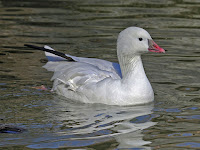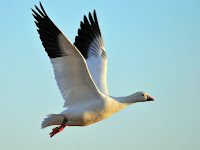ROSS'S GOOSE
ROSS’S GOOSE (Anser rossii) – (See images below)
DESCRIPTION: The Ross’s Goose white morph has a white plumage with black primaries. Eyes are black. Bill is orange with a grey base. Legs are pink. The rare blue morph has a dark grey plumage with a white head and rump. Sexes are similar. This is a small goose at about 60 cm (24 inches) long.
VOICE: https://www.xeno-canto.org/species/Anser-rossii
NAME: ‘Goose’ would have different origins, such as Dutch and German ‘Gans’, Old Norse ‘Gas’, even Spanish ‘Ganso’, to mean ‘goose’. This would relate to Latin ‘anser’ for ‘goose’. English name ‘Ross’s’ (and Latin species name rossii) was given to this goose to honor a Hudson’s Bay Company factor, Bernard R. Ross.
HABITAT: Tundra in the summer, grain fields, marshes and other shallow wetlands during migration and winter.
DIET: Plant material foraged on land or in shallow water.
NESTING: Breeds in colonies associated with snow geese. Nest is a mound of various materials placed on the ground. About three to five white eggs are laid, incubated by the female. Goslings reach the water soon after hatching, can feed themselves but cared for by parents.
DISTRIBUTION: Breeds in the tundra of central Canada – Baffin Island, Northwest Territories, west shores of Hudson’s Bay. Migrates across central Canada and central USA with groups reaching California. Winters in south central USA and north central Mexico.
Distribution Map: https://en.wikipedia.org/wiki/Ross%27s_goose#/media/File:Anser_rossii_map.svg
ON PEI: Does not breed on Prince Edward Island, sightings occasional in spring and fall, during migration.
CONSERVATION: Population has sizeably increased over last few decades, although still small. Not currently at risk.
NOTES: Found with snow geese in the winter, feeding in flocks.
SIMILAR SPECIES: Snow Goose (hybridizes with Ross’s goose)
REFERENCES: https://www.borealbirds.org/bird/rosss-goose
https://nature.mdc.mo.gov/discover-nature/field-guide/ross%E2%80%99s-goose (Missouri Department of Conservation)
http://fieldguide.mt.gov/speciesDetail.aspx?elcode=ABNJB04020 (Montana Field Guide)
https://en.wikipedia.org/wiki/Ross%27s_goose
https://www.allaboutbirds.org/guide/Rosss_Goose/id
https://birdatlas.mb.ca/accounts/speciesaccount.jsp?sp=ROGO&lang=en (Manitoba Breeding Bird Atlas)
http://www.ducks.org/hunting/waterfowl-id/ross-goose
https://www.audubon.org/field-guide/bird/rosss-goose
https://identify.whatbird.com/obj/293/_/Rosss_Goose.aspx
DESCRIPTION: The Ross’s Goose white morph has a white plumage with black primaries. Eyes are black. Bill is orange with a grey base. Legs are pink. The rare blue morph has a dark grey plumage with a white head and rump. Sexes are similar. This is a small goose at about 60 cm (24 inches) long.
VOICE: https://www.xeno-canto.org/species/Anser-rossii
NAME: ‘Goose’ would have different origins, such as Dutch and German ‘Gans’, Old Norse ‘Gas’, even Spanish ‘Ganso’, to mean ‘goose’. This would relate to Latin ‘anser’ for ‘goose’. English name ‘Ross’s’ (and Latin species name rossii) was given to this goose to honor a Hudson’s Bay Company factor, Bernard R. Ross.
HABITAT: Tundra in the summer, grain fields, marshes and other shallow wetlands during migration and winter.
DIET: Plant material foraged on land or in shallow water.
NESTING: Breeds in colonies associated with snow geese. Nest is a mound of various materials placed on the ground. About three to five white eggs are laid, incubated by the female. Goslings reach the water soon after hatching, can feed themselves but cared for by parents.
DISTRIBUTION: Breeds in the tundra of central Canada – Baffin Island, Northwest Territories, west shores of Hudson’s Bay. Migrates across central Canada and central USA with groups reaching California. Winters in south central USA and north central Mexico.
Distribution Map: https://en.wikipedia.org/wiki/Ross%27s_goose#/media/File:Anser_rossii_map.svg
ON PEI: Does not breed on Prince Edward Island, sightings occasional in spring and fall, during migration.
CONSERVATION: Population has sizeably increased over last few decades, although still small. Not currently at risk.
NOTES: Found with snow geese in the winter, feeding in flocks.
SIMILAR SPECIES: Snow Goose (hybridizes with Ross’s goose)
REFERENCES: https://www.borealbirds.org/bird/rosss-goose
https://nature.mdc.mo.gov/discover-nature/field-guide/ross%E2%80%99s-goose (Missouri Department of Conservation)
http://fieldguide.mt.gov/speciesDetail.aspx?elcode=ABNJB04020 (Montana Field Guide)
https://en.wikipedia.org/wiki/Ross%27s_goose
https://www.allaboutbirds.org/guide/Rosss_Goose/id
https://birdatlas.mb.ca/accounts/speciesaccount.jsp?sp=ROGO&lang=en (Manitoba Breeding Bird Atlas)
http://www.ducks.org/hunting/waterfowl-id/ross-goose
https://www.audubon.org/field-guide/bird/rosss-goose
https://identify.whatbird.com/obj/293/_/Rosss_Goose.aspx
 |
| Ross's goose, white morph adult, NC by Dick Daniels, Jan. 2011 |
 |
| Ross's goose, white morph juvenile, CA by 'Mike' Michael L. Baird |
 |
| Ross's goose blue morph with whites Kea Lake, WMA, NE, Don Henise |
 |
| Ross's goose adult white morph in flight by Tom Koerner, USFWS, WI |
 |
| Ross's goose with Snow goose, by Hybider |